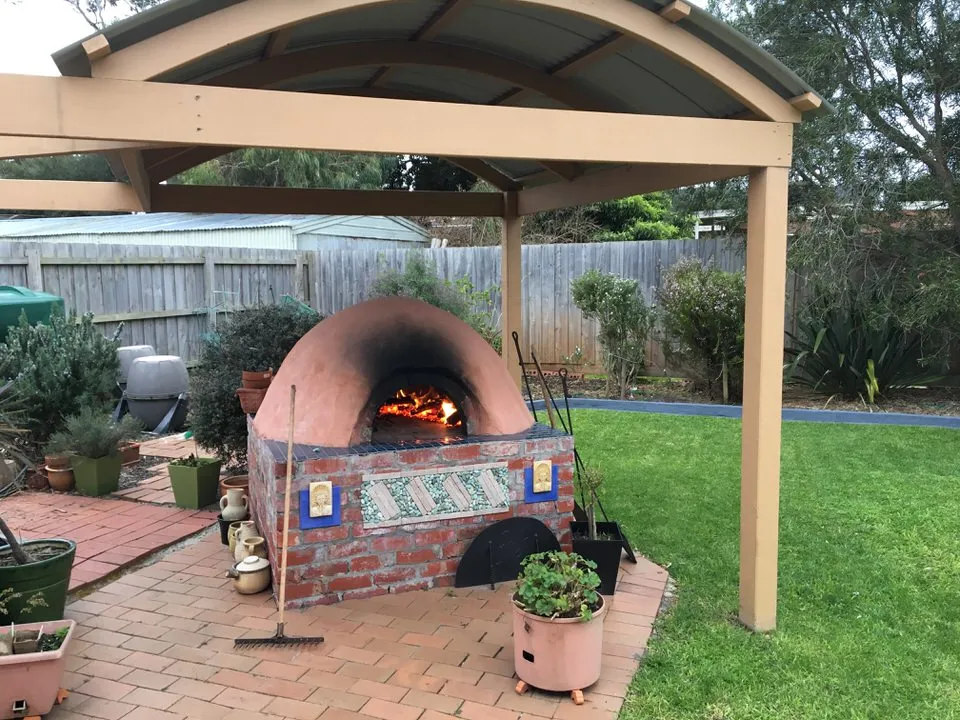I'm relatively new to my half-barrel brick oven, which I built myself last summer. I've got a couple of cookbooks for wood-fired ovens. They tell you to bring the oven to 450 degrees, or whatever, but they don't say what they mean by that. I use a laser thermometer to measure the temperatures of the walls, floor, etc. For pizza, I focus on the temp of the oven floor, but what do you measure for baking bread? It seems like the air temp would be more important than it is for pizza.
I'd love any suggestions for how you measure temperature for baking artisan bread.
Welcome aboard!
Photos of oven, Please!
Whose plans, and where/how did you obtain them?
What books/websites did you use, if any?
Our son-in-law has a dome type wood fired oven and he measure the temperature of both the floor and dome with a non-contact thermometer for bread. It is normal for him to make pizza one day (afternoon/evening) and then bake bread or roast chicken the next day. He does the pizza with wood fire push to the side / back and the arch door open. Most of the heat transferrer for the pizza comes from the walls and not the floor.
He then rakes out the wood coals and closes up the oven overnight and bakes / roasts the next day with the door closed.
Hope this helps a little.
This site https://www.traditionaloven.com has some great info from Rado a guy in Queensland Australia that sells his plans for ovens all over the world but has loads of free advice too. We built and used one from his design at the tech college i worked at.
My understanding is that when baking bread and the fire is raked out and the oven is closed up and allowed to rest the temperature settles and evens out through the effect of radiation. With Pizza where a fire is maintained the flame itself is radiating much more heat than the brickwork is releasing.
This piece is particularly relevant to your question.
Rectangular dome & round floor igloo dome typesregards Derek
Here is a follow up on the heat transfer to the pizza. https://www.pizzamaking.com/forum/index.php?topic=439.0
At the end of the day this technical issue really isn't important - what is important is that these ovens make the best pizza in my opinion. They also make great ovens for bread baking. Use and enjoy the ovens and what they bake / cook.
These notes are summarised from “The Art of Wood Fired Cooking” by Andrea Mugnaini.
No matter what cooking method you are planning to use, you must first bring the oven up to pizza temperature and then let it drop down to the appropriate environment. Once the oven is fully saturated with heat, each of the environments can be identified by the floor temperature and the size of the flame.
The only tool to use for measuring temperatures is the infrared thermometer. The only place to check is the floor.
Pizza Oven Environment
Floor temperature 345-400°C (650-750°F) with a flame rolling to the middle of the dome.
Roasting Oven Environment
Floor temperature 290°C (550°F) with a vertical flame extending up the wall only.
When roasting meats or poultry, start at 315°C (600°F) and then let the temperature drop slightly, maintaining 290°C (550°F).
Bake Oven Environment
Floor temperature of 180-235°C (350-450°F) with hot coals but no live flames.
Grilling Environment
Live coals only. The only time the oven doesn’t need to be preheated. Pull some live coals towards the archway.
Bread Oven Environment
Floor temperature of 235-290°C (450-550°F) empty oven.
Regulate the oven by closing the door. The oven will regulate to an even temperature throughout. If you need to oven to cool down faster, open the door for 10 minutes at a time. Check the floor temperature only after the door has been closed a minimum of 10 minutes, as the heat will migrate down.
Image

Thanks for those suggestions. My oven is a half-barrel shape (next time maybe I'll try a dome!), which I built based loosely on the instructions at Forno Bravo, though I built my own forms. Pizza always comes out great, and my last batch of ciabatta was quite good (my first successful artisan bread bake). I'm just trying to learn what I can to continue improving. Next week I hope to make the miche (or Poilane bread) that is featured on the cover of Peter Reinhart's Bread Baker's Apprentice, though I'm still working on how to generate steam.
I'd post pictures, but I can't figure out this website's system for doing it. Maybe my images are too big.
Please figure out how to post pictures as I would also love to see your oven.
Got fire bricks to built one, but currently dry stacked as a rocket stove ;)
This programm "photo compress" reduces picture size quite easily (android app)
OK, here is the whole sequence from digging the foundation to pulling out the first pizzas: https://photos.app.goo.gl/LEXgKCbEESXxbun36. I haven't figured out how to put captions on the pictures, but you can see just about every step of the process.
OK, here is the whole sequence from digging the foundation to pulling out the first pizzas: https://photos.app.goo.gl/LEXgKCbEESXxbun36. I haven't figured out how to put captions on the pictures, but you can see just about every step of the process.
Great work. It's a lot more intricate than my dome. The roof is essential to keep the weather out. I notice that you filled the cavity with insulation; good move.
Cheers,
Gavin
Nice!
Looks great and I'm jealous ;)
Thanks for the pictures